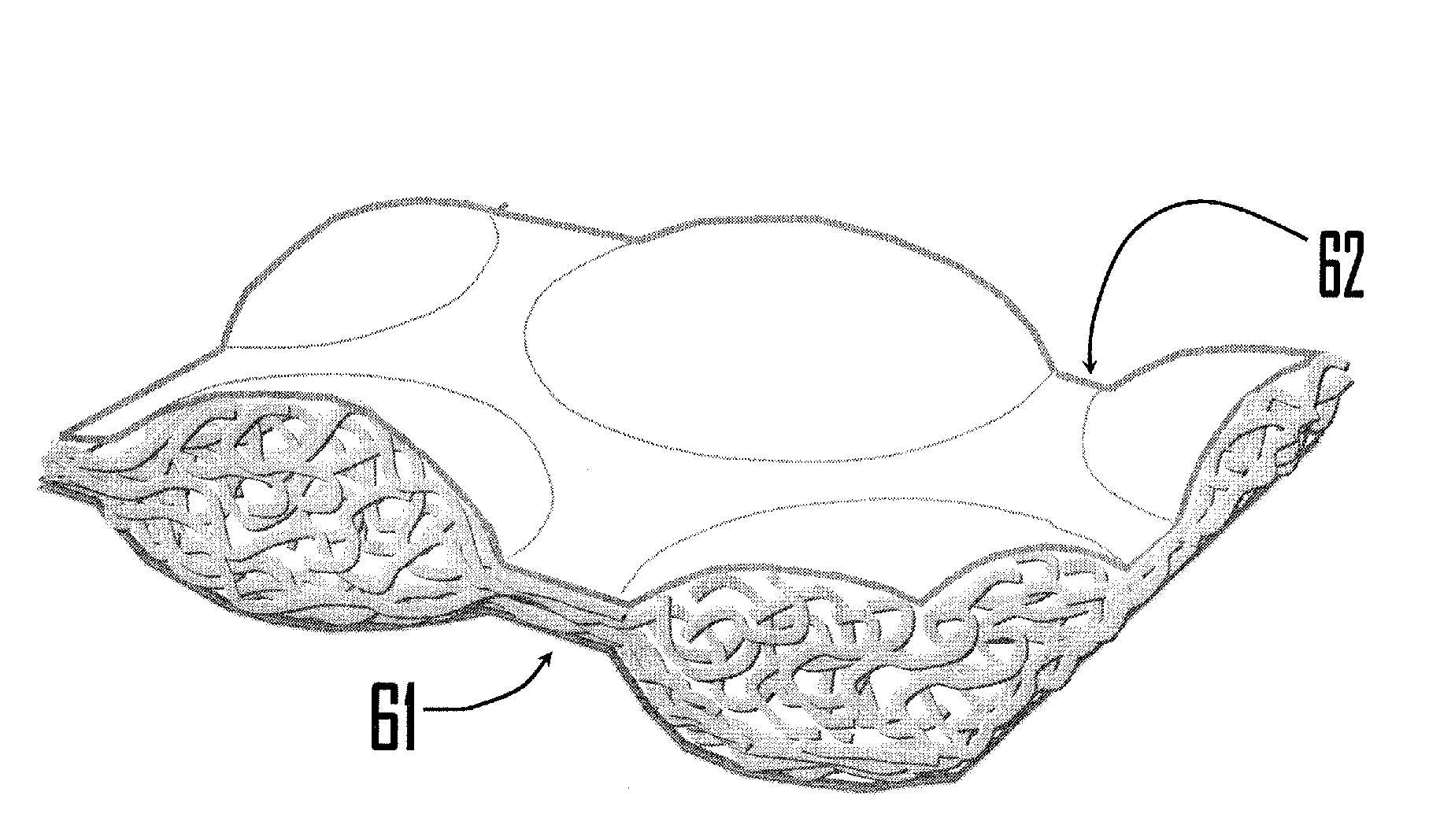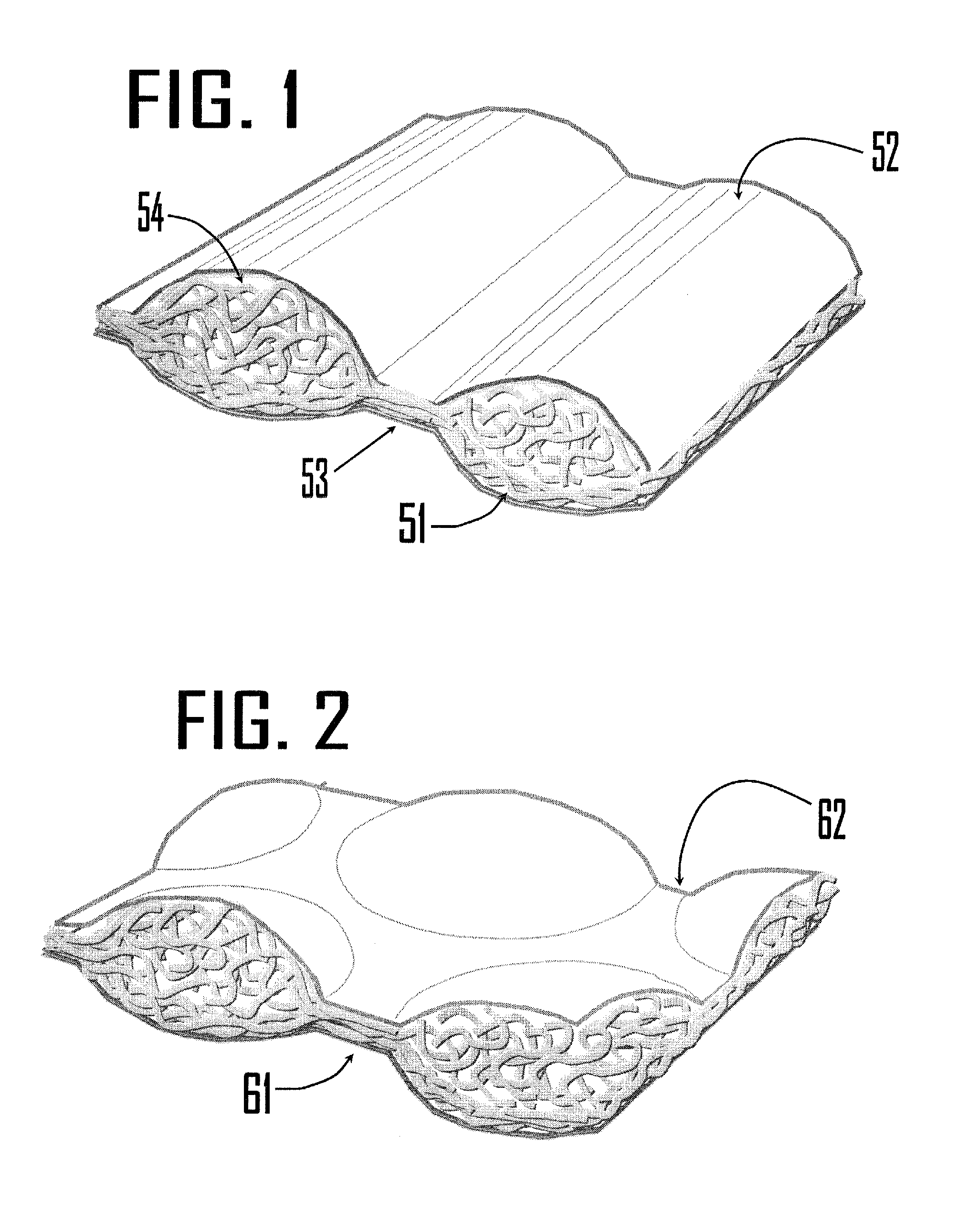Absorbent, nonwoven material exhibiting z-direction density gradient
a non-woven material and density gradient technology, applied in the field of absorbent materials, can solve the problems of high energy and capital expenditure of ovens required to bond the material at high speed, high cost of fibers, and large capital and energy-intensive bonding ovens, and achieve the effect of inhibiting the release of fibrous materials
- Summary
- Abstract
- Description
- Claims
- Application Information
AI Technical Summary
Benefits of technology
Problems solved by technology
Method used
Image
Examples
example 1
[0084]A nonwoven sheet material was made according to the present invention. The material comprised cellulosic fiber (Rayfloc J-LDE) from Rayonier, Jesup, Ga.), SAP (SA65s from Sumitomo Seika in Singapore) and 17 gsm 3995 tissue, (Cellu tissue, East Hartford, Conn). The first stratum formed had a total basis weight of 150 gsm, comprising cellulosic fiber and 15% SAP and included a layer of 17 gsm carrier tissue. Except for the carrier, the stratum was a homogeneous mix of SAP and cellulose, and was densified using a calender with a smooth surface on one roll and a linen pattern on the other heated to 170° C. at a sufficient pressure to yield a density of 0.31 g / cc. To this was added an additional stratum of material, with a total basis weight of 150 gsm, again comprising cellulosic fiber and SAP and including a layer of 17 gsm tissue, this time on the top. Except for the top tissue, the second stratum was likewise a homogeneous mix of SAP and Cellulose. This web was run through an e...
example 2
[0085]A material was made according to the present invention. The material comprised the same raw materials as Example 1. The first stratum had a total basis weight of 116 gsm, comprising cellulosic fiber and 30% SAP by weight and included a layer of 17 gsm carrier tissue. Except for the carrier, the stratum was a homogeneous mix of SAP and Cellulose, and was densified using a calender with a smooth surface on one roll and a linen pattern on the other heated to 170° C. at a sufficient pressure to yield a density of 0.28 g / cc. To this was added an additional stratum of material with a total basis weight of 111 gsm, again comprising cellulosic fiber and 25% SAP by weight and including a layer of 17 gsm tissue, this time on the top. Except for the top tissue, the second stratum was likewise a homogeneous mix of SAP and Cellulose and the web was run through an embossed calender, with the same embossing pattern as Example 1, heated to 170 C, with a sufficient force to produce a small are...
example 3
[0086]A material was made according to the present invention. The material comprised the same raw materials as Example 1. The first stratum had a total basis weight of 106 gsm, comprising cellulosic fiber and 25% SAP by weight and included a layer of 17 gsm carrier tissue. Except for the carrier, the stratum was a homogeneous mix of SAP and cellulose, and was densified using a calender with a smooth surface on one roll and a linen pattern on the other heated to 170° C. at a sufficient pressure to yield a density of 0.28 g / cc. To this was added an additional stratum of material with a total basis weight of 107 gsm, again comprising cellulosic fiber and 25% SAP by weight and including a layer of 17 gsm tissue, this time on the top. Except for the top tissue, the second stratum was likewise a homogeneous mix of SAP and cellulose. The web was run through an embossed calender, with the same embossing pattern as Example 1, heated to 170 C, with a sufficient force to produce a small area d...
PUM
| Property | Measurement | Unit |
|---|---|---|
| density | aaaaa | aaaaa |
| density | aaaaa | aaaaa |
| density | aaaaa | aaaaa |
Abstract
Description
Claims
Application Information
 Login to View More
Login to View More - R&D
- Intellectual Property
- Life Sciences
- Materials
- Tech Scout
- Unparalleled Data Quality
- Higher Quality Content
- 60% Fewer Hallucinations
Browse by: Latest US Patents, China's latest patents, Technical Efficacy Thesaurus, Application Domain, Technology Topic, Popular Technical Reports.
© 2025 PatSnap. All rights reserved.Legal|Privacy policy|Modern Slavery Act Transparency Statement|Sitemap|About US| Contact US: help@patsnap.com


